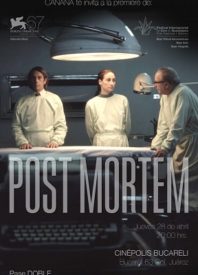
The 1973 military coup in Chile is, at first, an afterthought in Post Mortem. During its first 15 minutes, it’s still about a 55 year old morgue employee. That employee is Mario Cornejo (Alfredo Castro), who, in the beginning, drives his neighbor Nancy (Antonia Zegers) home. She twirls her hair, a flirtatious move that viewers don’t notice until repeat viewings. What’s apparent during a first watch is that Mario and Nancy will have a relationship doomed because of outside forces.
Pops of color exist in a world that eventually looks like it ha slayers or dust and rot. Post Mortem doesn’t have heroes like Allende in the foreground. Instead, viewers have Mario. He’s like what would happen if a Tati-esque protagonist was a creepy involuntary celibate. This seems harsh, but it harkens to the idea that microhistory has characters that have impulsive tendencies.
But even then, the film roots for the humanity within these sad characters. Mario’s human, nuanced side appears when he is with Nancy. There’s a scene where they both end up crying. Speaking from personal experience, most crying moments have one person expressing the emotion more than the other. But having both of them externalizing this outburst also shows a strange streak in Pablo Larrain. It’s one that keeps viewers watching.
Mario works at a morgue, but that’s not the only place in his life where rot manifests. Key scenes take place in his home where he’d be cooking dinner for himself. The film shows the textures of his home, one that he doesn’t have time to care for. This hints to how overextended he’ll be.
There are, unfortunately, a few things that set Post Mortem back. Outside of the occasional crying scene, most of the film feels emotionally detached. It eventually ties into historical events that more people know about, and that arc feels necessary yet slightly predictable. Not to mention that the transition between personal scenes and historical ones occasionally come with gag-like visuals. And those visuals sometimes involve Mario and his coworker Sandra (Amparo Noguera).
Viewers see a different side of Chile with these characters. And the further this film goes, the more we root for them. Nancy asks Mario whether or not the people looking for her will return. There’s a sense of urgency here. But at the risk of sounding naïve, I just want these characters to be good despite of signs pointing elsewhere.
Despite of this, Post Mortem shows power dynamics within characters that feel stronger despite who the president is in this country. It’s also a good showcase for Castro’s asking skills and Larrain’s directing. Larrain will eventually gain more attention for his films, showing his country through fresh eyes one film at a time.
Stream Post Mortem at OVID.

